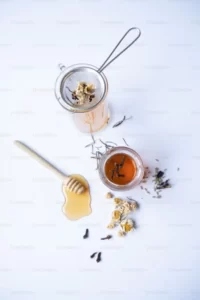Table of Contents
Manuka honey has gained attention for its potential antibacterial properties, making it a promising candidate for the treatment of surgical wounds. This article explores the antibacterial activity of different honeys, with a particular focus on manuka honey. It also discusses the factors that influence the strength of the antibacterial effect and the potential synergistic effects between different compounds in manuka honey.
Antibacterial Activity of Honeys
One of the key advantages of using manuka honey for surgical wounds is its antibacterial activity. This activity can be quantified using a model that allows for the comparison of different honeys and the assessment of their effectiveness. By comparing honeys with a reference honey, comparative statements can be made about their antibacterial properties.
The antibacterial activity of honeys can be attributed to their content of methylglyoxal (MGO), a compound known for its antibacterial properties. The higher the MGO content of a honey, the stronger its antibacterial effect. However, it is important to consider the activity of enzymes responsible for the degradation of antibacterial compounds, such as glyoxalase and catalase, when evaluating the bacteriostatic effect.
Factors Influencing the Antibacterial Effect
The strength of the antibacterial effect of manuka honey is dependent on its MGO content. Higher MGO contents in honey lead to longer lag phases, during which bacteria do not grow. The bacteriostatic effect is likely due to the degradation of MGO, either chemically or by microbial action. MGO can react with proteins in the liquid medium, reducing its concentration. If the MGO level drops below a certain concentration, bacteria are able to start growing. On the other hand, in the presence of high levels of MGO, bacteria do not grow during the measurement, indicating a bactericidal effect.
To evaluate the antibacterial effect of MGO, a bacterial model strain, such as Bacillus subtilis, can be used. This strain has a lower capacity to detoxify MGO, making it suitable for studying the antibacterial activity of manuka honey. Hydrogen peroxide, which is produced by glucose oxidase in honey, is not a significant antibacterial factor for B. subtilis, as the strain has catalase activity, which allows it to degrade hydrogen peroxide.
Evaluation of Commercial Manuka Honey Samples
To assess the antibacterial activity of commercial manuka honey samples, the previously mentioned assay was applied to four commercial manuka honeys labeled for wound healing purposes. The honeys were diluted to different concentrations with a 30% solution of artificial honey to achieve varying MGO levels. It was observed that higher MGO contents in the honeys resulted in higher growth delays of B. subtilis.
Synergistic Effects in Manuka Honey
In addition to MGO, other compounds in manuka honey may contribute to its antibacterial activity. To investigate potential synergistic effects, artificial honey spiked with MGO was used as a model system. Various compounds, including dihydroxyacetone (DHA), manuka honey protein, gallic acid, 3-phenyllactic acid (3-PLA), and 3-desoxyglucosone (3-DG), were added to the honey at relevant concentrations.
Among the compounds tested, only 3-PLA and gallic acid showed a synergistic effect with MGO. The addition of 3-PLA to artificial honeys containing high levels of MGO increased the growth delay of B. subtilis. This effect was observed in both artificial honeys and a manuka honey naturally containing MGO. The exact mechanism of the synergistic effect is still unknown, but it is hypothesized that 3-PLA stabilizes MGO in the medium and interacts with bacterial cell walls, increasing the susceptibility of the cells to MGO.
Gallic acid, representing the polyphenolic compounds in manuka honey, also enhanced the antibacterial effect of MGO. Higher levels of gallic acid in artificial honeys containing MGO resulted in higher growth delays. The content of 3-PLA and polyphenols in manuka honeys varied, and it was observed that honeys with higher levels of these compounds had higher growth delays against B. subtilis.
Conclusion
Manuka honey has shown promising antibacterial activity, making it a potential treatment option for surgical wounds. Its effectiveness is dependent on its MGO content, with higher MGO contents leading to stronger antibacterial effects. In addition, synergistic effects between MGO and other compounds, such as 3-PLA and gallic acid, may enhance the antibacterial activity of manuka honey. Further studies are needed to fully understand the mechanisms behind these synergistic effects and to optimize the use of manuka honey for surgical wound healing.



